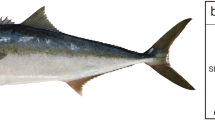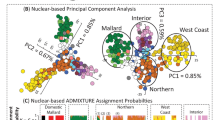The status of natural hybridization between the two Japanese geckos, Gekko tawaensis and Gekko japonicus, was surveyed by use of 15 diagnostic allozyme loci. Of 438 specimens examined, 9 were identified as Fl, 1 was a first backcross with G. japonicus, and 15 were identified as more successive generations. Hybridizations were detected at 7 of the 15 localities interspersed throughout a broad sympatric area of the two species, forming a mosaic hybrid zone. A comparison of species–hybrid composition between 2-year samples from a single locality and a 5-year interval showed no evidence for progressive introgression or establishment of a hybrid swarm, despite constant emergences of Fl hybrids. Nonprevalence of the hybrid genotypes was also indicated by the analysis using hybrid index scores for all other localities examined. These results suggest that strong selection acts against hybrid genotypes. Morphological features of hybrid individuals were also provided.



Similar content being viewed by others

REFERENCES
Anderson, E. (1948). Hybridization of the habitat. Evolution 2(1):1–9.
Baker, R. J., and Davis, S. K. (1989). Ribosomal-DNA, mitochondrial-DNA, chromosomal, and allozymic studies on a contact zone in the pocket gopher. Geomys. Evolution 43(1):63–75.
Barton, N. H., and Hewitt, G. M. (1985). Analysis of hybrid zones. Annu. Rev. Ecol. Syst. 16:113–148.
HAPSE (Hiba Association for the Promotion of Scientific Education) (1996). Amphibians and Reptiles in Hiroshima Prefecture, Chugoku-Shinbunsha, Hiroshima (in Japanese).
Harrison, R. G. (1993). Hybrids and hybrid zones: Historical perspective. In Harrison, R. G. (ed.), Hybrid Zones and the Evolutionary Process, Oxford University Press, New York, pp. 3–12.
Harrison, R. G., and Bogdanowicz, S. M. (1997). Patterns of variation and linkage disequilibrium in a field cricket hybrid zone. Evolution 51(2):493–505.
Harrison, R. G., and Rand, D. M. (1989). Mosaic hybrid zones and the nature of species boundaries. In Otte, D. and Endler, A. (eds.), Speciation and Its Consequences, Sinauer Associates, MA, pp. 111–133.
Hewitt, G. M. (1989). The subdivision of species by hybrid zones. In Otte, D. and Endler, A. (eds.), Speciation and Its Consequences, Sinauer Associates, MA, pp. 85–110.
Hillis, D. M., and Simmons, J. E. (1986). Dynamic change of a zone of parapatry between two species of Pholidobolus (Sauria: Gymnophthalmidae). J. Herpetol. 20(1):85–87.
Howard, D. J. (1993). Reinforcement: Origin, dynamics, and fate of an evolutionary hypothesis. In Harrison, R. G. (ed.), Hybrid Zones and the Evolutionary Process, Oxford University Press, New York, pp. 46–69.
Howard, D. J., Waring, G. L., Tibbets, C. A., and Gregory, P. G. (1993). Survival of hybrids in a mosaic hybrid zone. Evolution 47(3):789–800.
Jiggins, C. D., and Mallet, J. (2000). Bimodal hybrid zones and speciation. Trend. Ecol. Evol. 15(6):250–255.
JME (Japan Ministry of Environment) (1979). National Survey on the Natural Environment (Vegetation): Actual Vegetation Map, JME, Tokyo.
Kawata, H. (1980). Some notes on the gecko, Gekko tawaensis (Reptilia: Gekkonidae), of Kagawa Prefecture. Rep. Kagawa Prefectural Sci. Mus. 2:9–16 (in Japanese).
MacCallum, C. J., Nürnberger, B., Barton, N. H., and Szymura, J. M. (1998). Habitat preference in the Bombina hybrid zone in Croatia. Evolution 52(1):227–239.
Murphy, R. W., McCollum, P. C., Gorman, G. C., and Thomas, R. (1984). Genetics of hybridizing populations of Puerto Rican Sphaerodactylus. J. Herpetol. 18(2):93–105.
Murphy, R. W., Sites, J. W., Jr., Buth, D. G., and Haufler, C. H. (1996). Proteins: Isozyme electrophresis. In Hillis, D. M., Moritz, C., and Mable, B. K. (eds.), Molecular Systematics (2nd edn.), Sinauer Associates, Sunderland, pp. 51–120.
Okada, S., and Toda, M. (1998). New records of Gekko tawaensis from southwest Japan. Hibakagaku 189:1–12 (in Japanese with English abstract).
Ota, H. (1996). Gekko japonicus. In Sengoku, S., Hikida, T., Matsui, M., and Nakaya, K. (eds.), The Encyclopaedia of Animals in Japan. vol. 5: Amphibians, Reptiles, Chondrichthyes, Heibonsha, Tokyo, p. 69 (in Japanese).
Patton, J. L. (1993). Hybridization and hybrid zones in pocket gophers (Rodentia, Geomydae). In Harrison, R. G. (ed.), Hybrid Zones and the Evolutionary Process, Oxford University Press, New York, pp. 290–308.
Pritchard, J. K., Stephens, M., and Donnelly, P. (2000). Inference of population structure using multilocus genotype data. Genetics 155(2):945–959.
Schlefer, E. K., Romano, M. A., Guttman, S. I., and Ruth, S. B. (1986). Effect of twenty years of hybridization in a disturbed habitat on Hyla cinerea and Hyla gratiosa. J. Herpetol. 20(2):210–221.
Shibata, Y. (1980). Occurrences of Gekko tawaensis in Osaka Prefecture. Nat. Stud. 26(2):16–19 (in Japanese).
Sites, J. W., Jr., Barton, N. H., and Reed, K. M. (1995). The genetic structure of a hybrid zone between two chromosome races of the Sceloporus grammicus complex (Sauria, Phrynosomatidae) in central Mexico. Evolution 49(1):9–36.
Swofford, D. L., and Berlocher, S. H. (1987). Inferring evolutionary trees from gene frequency data under the principle of maximum parsimony. Syst. Zool. 36(3):293–325.
Toda, M., Okada, S., Ota, H., and Hikida, T. (2001). Biochemical assessment of evolution and taxonomy of the two morphologically poorly diverged geckos, Gekko yakuensis and G. hokouensis (Reptilia: Squamata), in Japan, with special reference to their occasional hybridization. Biol. J. Linnean Soc. 73(1):153–165.
Toda, M., Hikida, T., Okada, S., and Ota, H. (2003). Contrasting patterns of genetic variation in the two sympatric geckos Gekko tawaensis and G. japonicus (Reptilia: Squamata) from western Japan, as revealed by allozyme analyses. Heredity 90(1):90–97.
Tokunaga, S. (1984). Morphological variation and sexual dimorphism in Gekko japonicus from Fukuoka, northern Kyushu, Japan. Jpn. J. Herpetol. 10(3):80–88.
Wiens, J. J., and Servedio, M. R. (2000). Species delimitation in systematics: Inferring diagnostic differences between species. Proc. R. Soc. Lond. Ser. B 267:631–636.
ACKNOWLEDGMENTS
We thank H. Saito and M. Takeshima for their help in field collection. Financial support for this study was provided by a Research Fellowship of the Japan Society for the Promotion of Science for Young Scientists (9413 to MT) and a Grant-in-Aid from the Japan Ministry of Education, Science, Sports, and Culture (C-11833013 to HO), as well as by a Grant for Biodiversity Research of the Twenty-First Century COE (A14).
Author information
Authors and Affiliations
Corresponding author
APPENDIX: DEFINITIONS OF MORPHOLOGICAL CHARACTERS
APPENDIX: DEFINITIONS OF MORPHOLOGICAL CHARACTERS
-
TD, the number of irregular rows of dorsal tubercles counted transversely at mid-body.
-
TS, the presence or absence of tubercles on shank.
-
IN, the size of internasal in relation to the granule immediately posterior to it: small (S, smaller than 1.2 times), slightly enlarged (SL, as large as or larger than 1.2 times but not reaching 1.5 times), or enlarged (L, as large as or larger than 1.5 times).
-
PPM, condition of posterior scale of the postmentals, divided or undivided.
-
CS, the mean number of cloacal spurs on both sides.
-
PP, the number of preanal pores in males.
Rights and permissions
About this article
Cite this article
Toda, M., Okada, S., Hikida, T. et al. Extensive Natural Hybridization Between Two Geckos, Gekko tawaensis and Gekko japonicus (Reptilia: Squamata), Throughout Their Broad Sympatric Area. Biochem Genet 44, 1–17 (2006). https://doi.org/10.1007/s10528-006-9010-9
Received:
Accepted:
Published:
Issue Date:
DOI: https://doi.org/10.1007/s10528-006-9010-9



